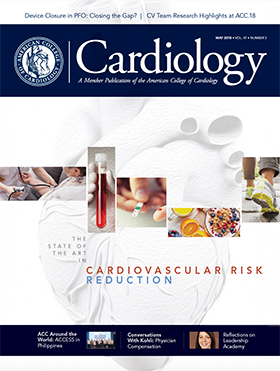From the Cardiovascular Team | Research Highlights CV Team Contributions to Improving Care, Outcomes

It takes a village. This oft-repeated proverb was well illustrated by research presented at ACC.18 in March that highlighted many different ways team-based care is used to improve patient care and understand cardiovascular disease.
Among the work presented: strategies to improve delivery in rural areas; use of advanced practice providers to help screen patients and decrease contrast-induced nephropathy; team-based approaches to reduce 30-day readmissions in heart failure patients; a team-based problem-solving approach for the discordance between aPTTs obtained by venipuncture and peripheral catheter; and more.
Award-winning research presented by Sharon Morgan, DNP, FNP-BC, AGACNP-BC, and Christine LaGresta, MS, RN, CPNP, in the Advanced Practice Nurses Committee poster session looked at improving patient safety by decreasing hospital readmission in cardiology patients and use of reported clinical descriptors of pneumothorax following pediatric cardiac surgery, respectively. In the Pharmacists Committee Fourth Annual Poster Session, research presented by Erika Giblin, PharmD, evaluated the need for individualized dosing of direct-acting oral anticoagulants (DOAC) in a real-world sample. Priyam Patel, PharmD, compared warfarin and DOAC therapy in treating left atrial appendage thrombus in atrial fibrillation (AFib)/flutter.
In a case presented by Sharon Dickinson, PA-C, AACC, on behalf of a multidisciplinary team of cardiovascular and medical professionals and CV Team members, a collaborative care approach to treating a 49-year-old man with acute coronary syndrome (ACS), cardiogenic shock and multisystem organ failure (MSOF) gave him a month with his family before he died.
According to Dickinson, the patient had a history of nonobstructive coronary artery disease and tobacco abuse and presented with NSTEMI. He had multivessel disease, including severe left main disease, and an ejection fraction of 10 percent. An Impella heart pump was placed and cardiothoracic surgery consulted. Overnight, the patient suffered asystole arrest leading to cardiogenic shock with MSOF. Later in his admission during hemodialysis catheter replacement, he suffered a repeat cardiac arrest.
She noted the lack of evidence to guide treatment for patients with ACS and cardiogenic shock and for patients with cardiogenic shock and MSOF required careful and strong collaboration between multiple subspecialty services and multiple disciplines. This included physicians, advanced practice providers, registered nurses, echo and vascular sonographers, pharmacists, Impella technicians, wound care specialists, among many others. In reviewing the case, Dickinson said an environment was created where the professionals worked together seamlessly with equal importance to their roles.
Starting with the initial evaluation in the emergency department, the cardiology PA played a key role, throughout the hospitalization, including medical/bedside management, decision making, facilitating communication between teams and coordination of care.
“With many new demands facing cardiovascular practices, team-based care is increasingly gaining traction to help meet these demands and ensure quality patient care and outcomes. Research, like that presented at ACC.18, plays an important role in testing ideas and identifying best practices,” says Eileen Handberg, PhD, ARNP, FACC.
CV Team Members Honored for Science
Viet T. Le, PA, AACC, and colleagues were recognized during ACC.18 for their work evaluating the prevalence of aspirin resistance in cardiac patients treated with low-dose enteric-coated aspirin (EC-ASA). Although low-dose aspirin is a preferred antiplatelet, concern was raised after a report in healthy volunteers that nearly half had initial antiplatelet resistance after a single 325 mg dose of EC-ASA, which was ascribed to poor absorption. Whether this extends to chronic low-dose EC-ASA therapy is uncertain.
Le and colleagues studied 60 consecutive patients (12 women) taking 81 mg EC-ASA daily for more than a month for primary (n=10) or secondary prevention of ischemic heart disease (n=46) or low-risk AFib (n=4). Only 15 percent of study patients had aspirin resistance, defined as aspirin reaction units (ARU) >550, and 85 percent had therapeutic ARU levels. No pattern emerged in relation to brand of EC-ASA and aspirin resistance. Bayer was most used and 14 of 17 patients taking this had therapeutic ARU levels.
Le, et al., concluded that while uncommon, aspirin resistance with EC-ASA was not rare in their study, thus raising the possibility of inadequate antiplatelet effect during chronic therapy in many patients in a broad, real-world setting. Further study is needed on poor absorption as a contributor to resistance, test variability and concealed medication nonadherence, along with potential benefit of routine testing and switching to non–EC-ASA as needed to improve therapeutic response.
In a separate study, Steve Mason, PA, reported work assessing the association of coronary flow reserve (CFR) values with angiographic stenosis on a per-vessel basis. Assessment of myocardial blood flow (MBF) by cardiac PET/CT has progressed the understanding of coronary atherosclerosis physiology. Attempts at establishing MBF values for determining ischemia have focused on CFR, a ratio of rest/stress MBF. But, these investigators noted the lack of independent assessment of absolute stress MBF and established normal CFR values for Rb-82 cardiac PET using regadenoson as a vasodilator.
In 1,290 consecutive patients who underwent clinically appropriate cardiac PET/CT assessment and subsequent coronary angiography within 30 days, stress MBF and CRF significantly differed by percent stenosis for each vessel.
MBF identified patients with nonobstructive coronary disease. For those with obstructive disease (>70 percent stenosis) sensitivity and specificity remained low. Marked differences were found between women and men for resting MBF and CFR. More work is needed for a better understanding of MBF and CFR values to ascertain more precise assessments of ischemia and levels of stenosis.
How well does the Lee Index predict 10-year mortality risk in adults with congenital heart disease (CHD)? Susan M. Fernandes, LPD, PA-C, and colleagues examined this in their single center study. Although scare, there is some evidence to suggest comorbidities may be at least as prevalent in patients with CHD as in an age-matched general population. The Lee Index has been validated for risk prediction in the general population and includes 12 independent predictors.
In the 370 patients, CHD was simple in 23 percent, moderate in 41 percent and complex in 35 percent. A significant difference in 10-year mortality by disease complexity was found. The mean 10-year mortality risk for patients <50 years was predicted to be 7.5, 9.9 and 12.8 percent in patients with simple, moderate and complex disease. A similar significant linear increase was seen in patients ≥50 years: 12.4, 18.7 and 28 percent, respectively. The Lee index may provide useful information for clinical decision making but a longitudinal study is warranted in adult CHD.
Keywords: ACC Publications, Cardiology Magazine, Accountable Care Organizations, Acute Coronary Syndrome, Anticoagulants, Aspirin, Atherosclerosis, Atrial Appendage, Atrial Fibrillation, Awards and Prizes, Blue Cross Blue Shield Insurance Plans, Centers for Medicare and Medicaid Services, U.S., Comorbidity, Consensus, Constriction, Pathologic, Coronary Angiography, Coronary Artery Disease, Decision Making, Dissent and Disputes, Emergency Service, Hospital, Fee-for-Service Plans, Health Resources, Healthy Volunteers, Heart Arrest, Heart Failure, Longitudinal Studies, Medicaid, Medicare, Medication Adherence, Myocardial Ischemia, Myocardial Infarction, Outcome Assessment, Health Care, Patient Care Team, Patient Readmission, Patient Safety, Personal Satisfaction, Pharmacists, Physician-Patient Relations, Phlebotomy, Physicians, Pneumothorax, Prevalence, Primary Health Care, Problem Solving, Purines, Pyrazoles, Renal Dialysis, Research Personnel, Secondary Prevention, Shock, Cardiogenic, Specialization, Stroke Volume, Telemedicine, Thrombosis, Traction, Unnecessary Procedures, Vasodilator Agents, Voluntary Programs, Warfarin, ACC18, ACC Annual Scientific Session
< Back to Listings

